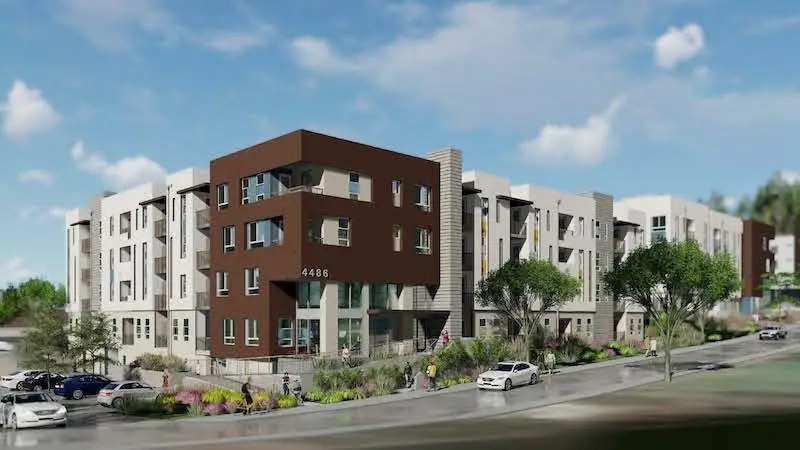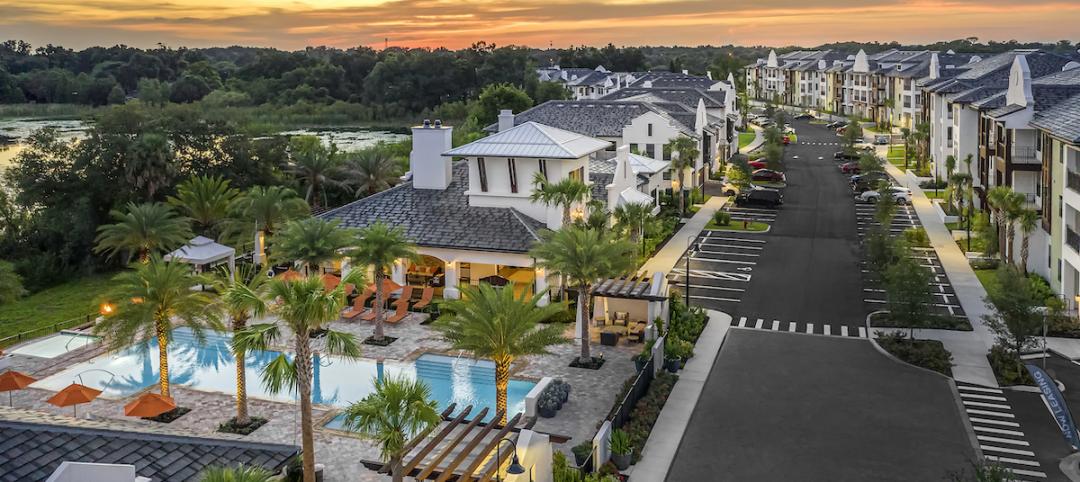Built in 1942, Rose Hill Courts is one of Los Angeles’ oldest public housing complexes. And led by a team that includes the Housing Authority of the City of Los Angeles (HACLA), the developer Related California, and the general contractor R.D. Olson Construction, the first phase of Rose Hill Courts’ redevelopment and expansion is underway to construct two Type V-A four-story wood-frame buildings with 51 and 38 units, respectively, and ground-level surface parking spaces.
Upon completion, this project will nearly double Rose Hill Courts to 185 affordable housing units for low, very low, and extremely low income families, and replace its existing 100 units set on five acres.
The two new buildings in phase one are designed to achieve LEED certification, and their construction is scheduled for completion at the end of next year. Totalling 103,000 sf, the two buildings will offer 51 one-bedroom, 26 two-bedroom, eight three-bedroom, and four four-bedroom apartments. One building will also have a 3,000-sf underground basement that makes use of an adjacent hill.
A GC COMMITTED TO AFFORDABLE HOUSING
R.D. Olson partnered with Withee Malcolm Architects on this project. Resource Environmental Inc., a hazardous material abatement and demolition contractor, performed abatement and demolition work that was completed prior to the financial closing and construction that started in June.
The Rose Hill Courts redevelopment is R.D. Olson’s fourth affordable housing project within a 10-mile radius of Los Angeles. “We bring the right experience along with well-established relationships in the community, and are successfully navigating the challenges of keeping the remaining 70-year-old residences operational during phase one of construction,” says Bill Wilhelm, R.D. Olson’s president.
Also see: L.A.’s component-based interim housing
According to HACLA’s website, phase two of the redevelopment will include 95 affordable apartment homes that target very low and extremely low income residents. Once both phases are completed, the redevelopment will include a 6,300-sf community building with and on-site property management office and social services, and a “Central Park” green space with shaded seating, barbeque grills, courtyards, and children’s play areas with “tot lots” for resident use.
Both phases will feature surface parking, a secured interior bike room, bike racks, entirely new landscaping, lighting, fencing, signage, security features, storm-drain and utility improvements. The new sustainably designed buildings will utilize solar power and the landscaping will include water-efficient irrigation and storm water reuse.
A HOMELESS PROBLEM THAT’S GETTING WORSE
Phase 1 of the redevelopment is financed with $31.8 million in tax-exempt bonds and $13.9 million in private equity raised through the sale of federal low-income housing tax credits. HACLA will provide up to $8.35 million during construction. This phase of redevelopment will also be supported by $15.5 million in funding from the State of California department of Housing and Community Development through the Affordable Housing & Sustainable Communities and Infill Infrastructure Grant programs.
In addition, $8 million in AHSC grant funds were awarded to the City of Los Angeles to provide pedestrian safety upgrades in the immediate neighborhood and improvements in public transportation including six new bus shelters and eight battery electric buses.
The Rose Hill Courts redevelopment is occurring at a time when homelessness in southern California has been rising. On any given night there are more than 66,000 people homeless in Los Angeles County, and 739 homeless died in the county in the first six months of 2021, 20% more than during the same period in 2020. In July, L.A. County approved $527.1 million in funding to battle homelessness in fiscal 2012-22.
Related Stories
Multifamily Housing | Dec 16, 2020
What the Biden Administration means for multifamily construction
What can the multifamily real estate sector expect from Biden and Company? At the risk of having egg, if not a whole omelet, on my face, let me take a shot.
Giants 400 | Dec 16, 2020
Download a PDF of all 2020 Giants 400 Rankings
This 70-page PDF features AEC firm rankings across 51 building sectors, disciplines, and specialty services.
Multifamily Housing | Dec 4, 2020
The Weekly show: Designing multifamily housing for COVID-19, and trends in historic preservation and adaptive reuse
This week on The Weekly show, BD+C editors spoke with leaders from Page & Turnbull and Grimm + Parker Architects about designing multifamily housing for COVID-19, and trends in historic preservation and adaptive reuse
Giants 400 | Dec 2, 2020
2020 Multifamily Sector Giants: Top architecture, engineering, and construction firms in the U.S. multifamily building sector
Clark Group, Humphreys & Partners Architects, and Kimley-Horn head BD+C's rankings of the nation's largest multifamily building sector architecture, engineering, and construction firms, as reported in the 2020 Giants 400 Report.
Smart Buildings | Nov 20, 2020
The Weekly show: SPIRE smart building rating system, and pickleball court design tips
The November 19 episode of BD+C's The Weekly is available for viewing on demand.
AEC Tech | Nov 12, 2020
The Weekly show: Nvidia's Omniverse, AI for construction scheduling, COVID-19 signage
BD+C editors speak with experts from ALICE Technologies, Build Group, Hastings Architecture, Nvidia, and Woods Bagot on the November 12 episode of "The Weekly." The episode is available for viewing on demand.
Multifamily Housing | Nov 11, 2020
San Jose affordable housing project will feature a mass timber frame
SERA Architects and Lendlease will design and build the project.
Multifamily Housing | Oct 30, 2020
The Weekly show: Multifamily security tips, the state of construction industry research, and AGC's market update
BD+C editors speak with experts from AGC, Charles Pankow Foundation, and Silva Consultants on the October 29 episode of "The Weekly." The episode is available for viewing on demand.
Multifamily Housing | Oct 29, 2020
Uncertainty shades a once-soaring multifamily construction market
Demand varies by region, and by perceptions about the economy, COVID-19, and the election.

















